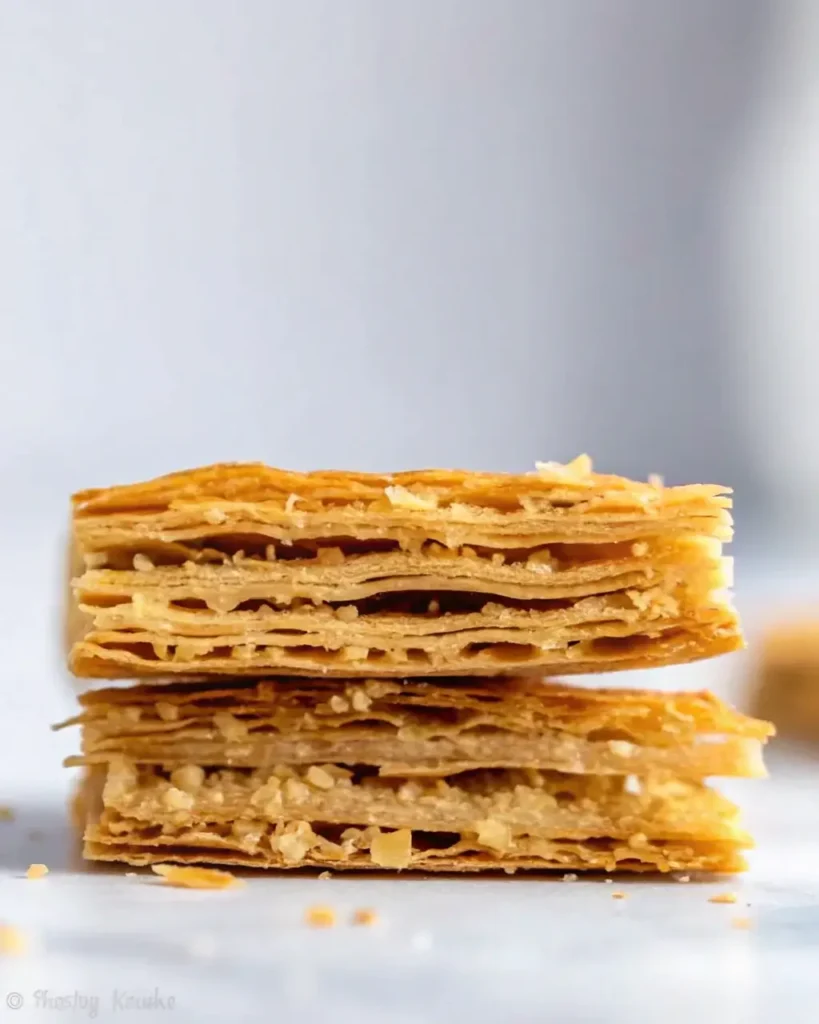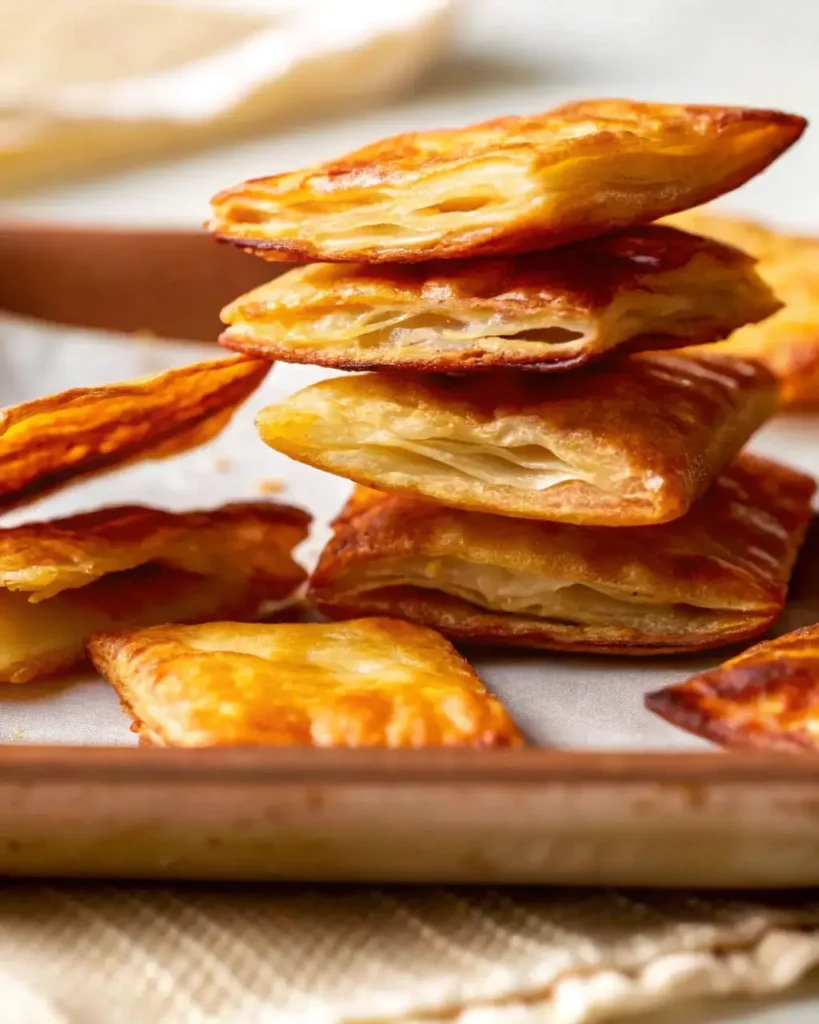Gluten-Free Puff Pastry: How to Make, Use, and Enjoy It

Introduction
For anyone with gluten intolerance or celiac disease, finding a good gluten-free puff pastry can feel like hitting the jackpot. This versatile ingredient opens up a world of possibilities, from flaky pastries to savory pies and sweet desserts. While traditional puff pastry relies on gluten to create its characteristic layers, gluten-free alternatives offer the same delicious results without compromising on dietary needs.
In this guide, we’ll explore everything about gluten-free puff pastry: what it is, how to make it, how it compares to traditional puff pastry, and the best ways to use it in recipes. We’ll also answer common questions, like whether it tastes the same and why some gluten-free brands don’t freeze well. If you’re looking for a gluten-free puff pastry solution, this article has you covered!
Table of Contents
What Is Gluten-Free Puff Pastry?
How It Differs From Traditional Puff Pastry
Traditional puff pastry is made with wheat flour, which contains gluten. Gluten is essential for creating the elastic dough that traps steam and forms those signature flaky layers. Gluten-free puff pastry, on the other hand, uses alternative flours like rice, almond, or tapioca flour to replicate this effect. While it lacks the natural elasticity of gluten, it relies on clever techniques and binding agents like xanthan gum to achieve a similar texture.
Ingredients Used in Gluten-Free Puff Pastry
Unlike traditional pastry, gluten-free versions often blend multiple flours to mimic the properties of wheat. Common ingredients include:
- Rice Flour: Provides structure and lightness.
- Tapioca Flour: Adds elasticity to the dough.
- Potato Starch: Enhances fluffiness and texture.
- Xanthan Gum or Psyllium Husk: Helps bind the dough together, compensating for the lack of gluten.
Texture and Flavor Expectations
Gluten-free puff pastry may feel slightly denser than its traditional counterpart, but it still delivers a satisfying flakiness when baked. The flavor is neutral, making it ideal for both sweet and savory dishes. When prepared correctly, it’s hard to tell the difference!
How to Make Gluten-Free Puff Pastry from Scratch
Essential Ingredients You’ll Need
Making gluten-free puff pastry at home requires the right combination of ingredients to achieve the perfect balance of texture and flavor. Here’s what you’ll need:
- Gluten-Free Flour Blend: A combination of rice flour, tapioca starch, and potato starch.
- Butter or Dairy-Free Substitute: Cold, unsalted butter is key to creating the flaky layers. For a dairy-free option, use a plant-based butter substitute.
- Cold Water: Helps bind the ingredients without overworking the dough.
- Xanthan Gum or Psyllium Husk: Acts as a binding agent to replicate the elasticity of gluten.
- Salt: Enhances the flavor of the dough.
Step-by-Step Instructions for Homemade Puff Pastry
- Combine the Dry Ingredients: In a large bowl, mix the gluten-free flour blend, xanthan gum, and salt.
- Incorporate the Butter: Add chilled, cubed butter to the flour mixture. Use a pastry cutter or your fingers to mix until the texture resembles coarse crumbs.
- Add Cold Water: Gradually stir in cold water, 1 tablespoon at a time, until the dough comes together. It should be slightly sticky but not wet.
- Roll Out the Dough: On a floured surface, roll the dough into a rectangle. Fold the dough into thirds, like a letter, and rotate 90 degrees.
- Repeat the Folding Process: Roll, fold, and rotate the dough 4-6 times, chilling it in the refrigerator for 30 minutes between folds to maintain the butter’s consistency.
- Final Chill: Wrap the dough in plastic wrap and refrigerate for at least 2 hours before using.

Pro Tips for Getting That Flaky Texture
- Keep Everything Cold: Cold butter and water are crucial for creating flaky layers. Work quickly to prevent the butter from melting.
- Don’t Overwork the Dough: Handle it as little as possible to avoid a tough texture.
- Use Light, Even Pressure: When rolling out the dough, maintain even pressure to ensure uniform layers.
By following these steps, you’ll have a versatile gluten-free puff pastry that rivals traditional versions in both flavor and texture.

Does Gluten-Free Puff Pastry Taste the Same?
Comparing Gluten-Free and Traditional Puff Pastry
Gluten-free puff pastry is a remarkable alternative to traditional versions, but it does have some differences. The texture of gluten-free pastry tends to be slightly denser because it lacks the elasticity gluten provides. However, when baked correctly, it still delivers those signature flaky layers that puff pastry is known for.
The flavor is another area where gluten-free puff pastry shines. Its neutral taste makes it just as versatile as its traditional counterpart, whether you’re making sweet desserts or savory appetizers. With the right balance of ingredients and techniques, the difference is almost imperceptible.
Key Factors That Influence Taste
Several factors can influence the taste and texture of gluten-free puff pastry:
- Quality of the Flour Blend: Using a well-balanced gluten-free flour mix is crucial. Poor-quality flours can lead to a grainy or dry texture.
- Freshness of Ingredients: Fresh butter and properly stored flours enhance the overall flavor.
- Baking Technique: Overbaking or underbaking can alter the taste and texture, making it less appealing.
Adjustments to Improve Flavor and Texture
If you’re making gluten-free puff pastry at home, consider these adjustments to enhance its taste:
- Add a Touch of Sweetness: For dessert recipes, include a teaspoon of sugar in the dough.
- Use High-Quality Butter: European-style butter with a higher fat content can improve both flavor and texture.
- Incorporate Flavors: Add herbs, spices, or citrus zest to the dough for a unique twist.
While gluten-free puff pastry may have subtle differences, these tweaks can bring it closer to the traditional experience, satisfying even the most discerning palates.
Can Celiacs Eat Puff Pastry?
What to Look for in Gluten-Free Certification
Celiacs can safely enjoy puff pastry if it’s explicitly labeled as gluten-free. Certification by trusted organizations, such as the Gluten-Free Certification Organization (GFCO), ensures that the product contains less than 20 parts per million (ppm) of gluten, meeting the safety standards for individuals with celiac disease. Always look for a certified gluten-free label on store-bought puff pastry.
Common Traps to Avoid When Shopping for Puff Pastry
Not all products marketed as “gluten-free” are safe for celiacs. Here are a few things to watch out for:
- Cross-Contamination Risks: Check for statements about shared facilities or equipment with gluten-containing products.
- Hidden Gluten Ingredients: Some puff pastry may contain malt or other derivatives that are not gluten-free. Always read the ingredient list carefully.
- Unverified Labels: Products without certification could still contain traces of gluten, so stick to brands that explicitly state their gluten-free credentials.
Safety Tips for Celiacs Using Gluten-Free Products
To ensure safety when consuming gluten-free puff pastry:
- Research Trusted Brands: Brands like Schär or GeeFree are known for their celiac-safe puff pastry options.
- Home Preparation: Making your own puff pastry is the safest option, as you have full control over the ingredients and preparation.
- Separate Utensils and Surfaces: Avoid cross-contamination by using dedicated utensils, cutting boards, and baking sheets for gluten-free cooking.
By following these precautions, celiacs can confidently enjoy puff pastry without compromising their health.
The Best Substitutes for Puff Pastry
Gluten-Free Alternatives Like Phyllo Dough or Pie Crust
If you don’t have gluten-free puff pastry on hand, there are several substitutes that can work in its place:
- Gluten-Free Phyllo Dough: While thinner than puff pastry, it can replicate the flaky layers for recipes like baklava or spanakopita.
- Gluten-Free Pie Crust: This option works well for tarts, quiches, or pies. While not as flaky, it provides a solid base for sweet or savory dishes.
Using Rice Paper or Gluten-Free Tortillas
For lighter alternatives, consider:
- Rice Paper Wrappers: Perfect for appetizers like spring rolls or small pastries. While not traditional, they create a crisp, delicate layer when baked.
- Gluten-Free Tortillas: Use these for quick turnovers or wraps. While they lack the buttery texture of puff pastry, they can be a convenient and tasty substitute.
Creative Substitutes for Puff Pastry in Desserts
When crafting desserts, some unconventional options can replicate puff pastry’s effects:
- Gluten-Free Croissant Dough: If you have access to gluten-free croissant dough, it can mimic the texture and layers of puff pastry.
- Mashed Potatoes or Polenta: Use as a topping for pot pies or casseroles instead of puff pastry for a unique twist.
- Puff Pastry Sheets from Trusted Brands: Refer to this guide on puff pastry dessert recipes for more creative ways to use gluten-free options.
Pro Tip:
When substituting puff pastry in recipes, adjust the baking time and temperature accordingly. Some alternatives may require a lower temperature to avoid drying out or burning.
With these substitutes, you can adapt your favorite recipes and enjoy the versatility of puff pastry, even without the traditional version.
Why Can’t You Freeze Jus Rol Gluten-Free Puff Pastry?
How Freezing Affects Gluten-Free Pastry Dough
Unlike traditional puff pastry, gluten-free pastry dough doesn’t freeze as well due to the absence of gluten. Gluten provides elasticity and structure, which helps maintain the dough’s integrity during freezing and thawing. In gluten-free dough, the binding agents like xanthan gum or psyllium husk are less stable when frozen, causing the dough to become brittle or lose its desired texture.
Best Practices for Storing Gluten-Free Puff Pastry
If you can’t freeze Jus Rol gluten-free puff pastry, consider these alternatives to maintain its freshness:
- Refrigerate Instead: Store unused pastry dough in an airtight container or tightly wrapped in plastic wrap in the refrigerator. Use it within 1-2 days for best results.
- Pre-Bake Portions: Bake the pastry sheets or shapes you’ll need for future recipes, and store them in an airtight container. Reheat before serving to enjoy a crispy texture.
- Avoid Refreezing Thawed Dough: If the dough has already been thawed, refreezing can compromise its texture further.
Alternatives to Freezing for Longevity
For longer storage options without freezing, you can:
- Vacuum Seal the Dough: Removing excess air can extend its refrigerated shelf life.
- Store in Portions: Divide the dough into smaller portions and wrap each one tightly, so you only use what you need.
- Consider Homemade Dough: Homemade gluten-free puff pastry can be customized to include stabilizers that freeze better, such as additional xanthan gum or egg whites.
Understanding why some gluten-free puff pastry brands, like Jus Rol, don’t freeze well can help you better manage storage and plan for your baking needs.
Popular Gluten-Free Puff Pastry Recipes
Sweet Treats Using Gluten-Free Puff Pastry
Gluten-free puff pastry is a fantastic base for a variety of sweet desserts. Here are a few ideas to inspire your baking:
- Gluten-Free Apple Turnovers: Flaky pastry filled with spiced apple filling and topped with a sprinkle of sugar. Perfect for a warm, comforting treat.
- Strawberry Puff Pastry Tart: Layer gluten-free puff pastry with cream cheese and fresh strawberries for a simple yet elegant dessert.
- Chocolate-Filled Pastries: Fold squares of puff pastry around chocolate pieces, bake until golden, and dust with powdered sugar for a decadent bite.
Savory Dishes to Try
This versatile pastry is also great for savory recipes:
- Gluten-Free Sausage Rolls: Wrap puff pastry around gluten-free sausages for a quick appetizer or snack.
- Vegetable Puffs: Fill pastry with sautéed vegetables and spices for a delicious vegetarian option.
- Chicken Pot Pie: Use gluten-free puff pastry as a crust for creamy, hearty chicken pot pie.
Tips for Adapting Traditional Recipes to Gluten-Free
When converting traditional puff pastry recipes to gluten-free, keep these tips in mind:
- Adjust Cooking Times: Gluten-free puff pastry may bake faster or slower than traditional pastry, so keep an eye on it to avoid overbaking.
- Use Fresh Ingredients: Gluten-free dough can be more sensitive to moisture, so ensure your fillings aren’t too watery to prevent soggy pastry.
- Experiment with Layers: Brush butter or oil between folds during preparation to enhance flakiness.

Bonus Inspiration:
For more dessert ideas featuring puff pastry, check out this guide on puff pastry dessert recipes to discover creative ways to satisfy your sweet tooth.
Gluten-free puff pastry opens up a world of culinary possibilities, whether you’re making classic recipes or experimenting with new ones.
Tips for Storing and Serving Gluten-Free Puff Pastry
Best Practices for Storing Gluten-Free Puff Pastry
To keep your gluten-free puff pastry fresh and ready for use, follow these storage tips:
- Refrigerate Unused Dough: Wrap the dough tightly in plastic wrap and store it in an airtight container. Use within 2-3 days to maintain its quality.
- Avoid Moisture Exposure: Ensure the dough is completely dry before wrapping it to prevent sogginess.
- Store Baked Pastry Separately: If you’ve baked the pastry, let it cool completely before storing it in an airtight container at room temperature for up to 2 days.
Can You Freeze Gluten-Free Puff Pastry?
Some gluten-free puff pastries, like Jus Rol, are not recommended for freezing due to texture changes. However, for freezer-safe dough:
- Divide the dough into portions and wrap each tightly in plastic wrap.
- Place wrapped portions in a freezer-safe bag and label with the date.
- Thaw overnight in the refrigerator before use.
Serving Suggestions
- For Sweet Dishes: Dust with powdered sugar or serve with whipped cream for a decadent touch.
- For Savory Dishes: Pair with dips like hummus or a spicy tomato chutney.
- As a Snack: Bake small, plain pieces of puff pastry and sprinkle with cinnamon sugar or garlic seasoning.
Proper storage and thoughtful serving ideas ensure your gluten-free puff pastry is always a hit, whether baked fresh or prepared in advance.


Homemade Gluten-Free Puff Pastry
Description
This Homemade Gluten-Free Puff Pastry is the perfect solution for those craving buttery, flaky layers without the gluten. Using a combination of gluten-free flours and xanthan gum, this versatile pastry dough can be used for everything from sweet desserts to savory pies. With step-by-step instructions, you’ll master the art of gluten-free puff pastry in no time!
Ingredients
For the Puff Pastry Dough:
- 2 cups gluten-free flour blend (with a mix of rice flour, tapioca starch, and potato starch)
- 1 teaspoon xanthan gum
- ½ teaspoon salt
- 1 cup cold unsalted butter (or plant-based butter for a dairy-free option), cubed
- 6–8 tablespoons cold water
- Extra gluten-free flour for dusting
Instructions
- Mix the Dry Ingredients:
- In a large mixing bowl, whisk together the gluten-free flour blend, xanthan gum, and salt.
- Incorporate the Butter:
- Add the cold, cubed butter to the flour mixture. Using a pastry cutter or your fingers, work the butter into the flour until the mixture resembles coarse crumbs with some larger pea-sized chunks.
- Add Water to Form Dough:
- Gradually add cold water, 1 tablespoon at a time, while mixing gently. Stop adding water once the dough comes together but isn’t sticky. Avoid overworking the dough.
- Roll and Fold the Dough:
- Lightly dust a clean surface with gluten-free flour. Roll the dough into a rectangle.
- Fold the dough into thirds like a letter. Turn the dough 90 degrees, then roll it out again into a rectangle.
- Repeat the folding and rolling process 4–6 times, refrigerating the dough for 20 minutes between each roll to keep the butter cold.
- Chill the Dough:
- Wrap the folded dough tightly in plastic wrap and refrigerate for at least 2 hours, or overnight, before using.
Notes
- Variations: Add a teaspoon of sugar to the dough for dessert recipes or fresh herbs for savory dishes.
- Troubleshooting: If the dough becomes too soft to handle, refrigerate it for 15–20 minutes before continuing.
Enjoy the satisfaction of creating your own gluten-free puff pastry, perfect for elevating any recipe! Let me know if you’d like recipes for specific dishes to use with this pastry. 😊
Frequently Asked Questions About Gluten-Free Puff Pastry
Does Gluten-Free Puff Pastry Taste the Same?
Gluten-free puff pastry can closely mimic the taste of traditional pastry when made or purchased from a quality source. While it may have a slightly denser texture, the neutral flavor works well in both sweet and savory dishes. Proper baking techniques, fresh ingredients, and quality butter or dairy-free substitutes can help achieve the classic puff pastry experience.
Can Celiacs Eat Puff Pastry?
Yes, celiacs can safely eat puff pastry if it is certified gluten-free. Look for trusted brands like Jus Rol or Schär, which produce products that meet gluten-free standards. Always check for potential cross-contamination and choose certified options to ensure they are safe for those with celiac disease.
What Is the Best Substitute for Puff Pastry?
If gluten-free puff pastry is unavailable, you can try substitutes like:
Gluten-Free Phyllo Dough: For layered dishes.
Gluten-Free Pie Crust: For tarts and quiches.
Rice Paper Wrappers or Gluten-Free Tortillas: For lighter, crispier alternatives.
For inspiration, explore this guide to puff pastry dessert recipes to discover creative substitutes
Why Can’t You Freeze Jus Rol Gluten-Free Puff Pastry?
Freezing gluten-free puff pastry can compromise its texture because it lacks the elasticity gluten provides. When thawed, the dough may become brittle or crumbly. To store it effectively, refrigerate unused portions or pre-bake sheets for later use. Alternatively, homemade puff pastry with stabilizing ingredients like xanthan gum may freeze better.
FAQs provide clarity on using and enjoying gluten-free puff pastry, making it easier for readers to feel confident about their baking ventures.
Conclusion
Gluten-free puff pastry opens up a world of delicious possibilities for those with gluten intolerance or celiac disease. Whether you’re using a store-bought option or making it from scratch, this versatile ingredient lets you enjoy a wide variety of recipes without compromising on taste or texture. From sweet treats like apple turnovers to savory dishes like sausage rolls, gluten-free puff pastry is a game-changer in the kitchen.
While it may require special ingredients and techniques, the effort is well worth it for the flaky, buttery results. By following this guide, you’ll gain confidence in preparing, storing, and using gluten-free puff pastry to suit your needs. We’ve also shared creative substitutes and recipe ideas to inspire you further.
If you’re ready to start baking, don’t forget to explore this guide on puff pastry dessert recipes for even more ways to put your puff pastry to good use. Whether you’re a seasoned baker or a beginner, gluten-free puff pastry can be the centerpiece of your next culinary adventure.
Now it’s your turn to try! Share your experiences, tips, or favorite recipes in the comments, and let us know how you’ve made gluten-free puff pastry part of your kitchen repertoire.

